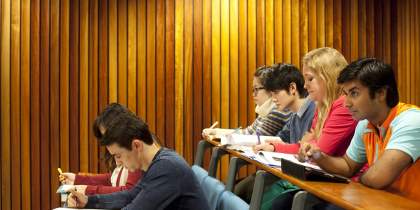
September 14, 2004, by Teaching at Nottingham
The acoustics of teaching facilities: a case study of the University of Nottingham
Peter Rutherford: “The acoustical design of lecture theatres, seminar rooms and classrooms is of paramount importance in meeting the required speech intelligibility for delivering effective teaching, irrespective of the teaching style employed. Given the nature of universities delivering content, new information is presented at such intensity that it is essential that speech intelligibility meet the demands for such teaching. Whilst poor acoustics will degrade speech intelligibility for those who have a common first language (i.e. native speakers), those also likely to be affected are students learning in a second language, as well as those who have the disability of mild to moderate hearing loss. Therefore the need for good acoustics is an essential part of a successful learning experience!
“The purpose of this presentation therefore is to investigate the acoustics of several teaching facilities as offered by the University, including both University Park and the new Jubilee Campus. A general survey of the acoustics of teaching facilities will be discussed followed by an in-depth analysis of the best and worst spaces as offered by the University. Listening tests were subsequently conducted on these spaces using both native and non-native listeners to investigate the effect of room acoustics on their ability to recognise spoken words, the results of which will be discussed at length.”
In summary, the investigation found:
- Significant variation in the quality of acoustics between lecture theatres and seminar rooms, many of which offered good acoustics, but were still far from optimal.
- Significant variation in the quality of acoustics within rooms, therefore disadvantaging certain students.
- That listening tests proved that word recognition was adversely affected by poor room acoustics, irrespective of language ability therefore correlating strongly with the measured speech transmission metrics.
- That the reduction in acoustical quality had a significantly greater effect on non-native listeners’ word recognition ability.
- That whereas lost words may be compensated by language context in native listeners, these high-level language skills are likely to be less developed in non-native listeners therefore having a significantly greater impact on learning.
- That many of these room acoustics problems can be solved by adopting good lecturing practice, vocal projection into audience as opposed to oblique to audience, making use of voice enhancement systems (assuming these are fit for purpose), and so on.
- That there are relatively simple and inexpensive techniques that may be employed in remedying acoustical defects within many of the spaces investigated
Peter Rutherford
Associate Professor, Institute of Architecture, Faculty of Engineering
Department of Architecture and the Built Environment
Note
- Paper presented at the University’s Fifth Learning & Teaching conference (September, 2004)
- This project was funded in part by the University’s Learning & Teaching Development Fund
No comments yet, fill out a comment to be the first

Leave a Reply